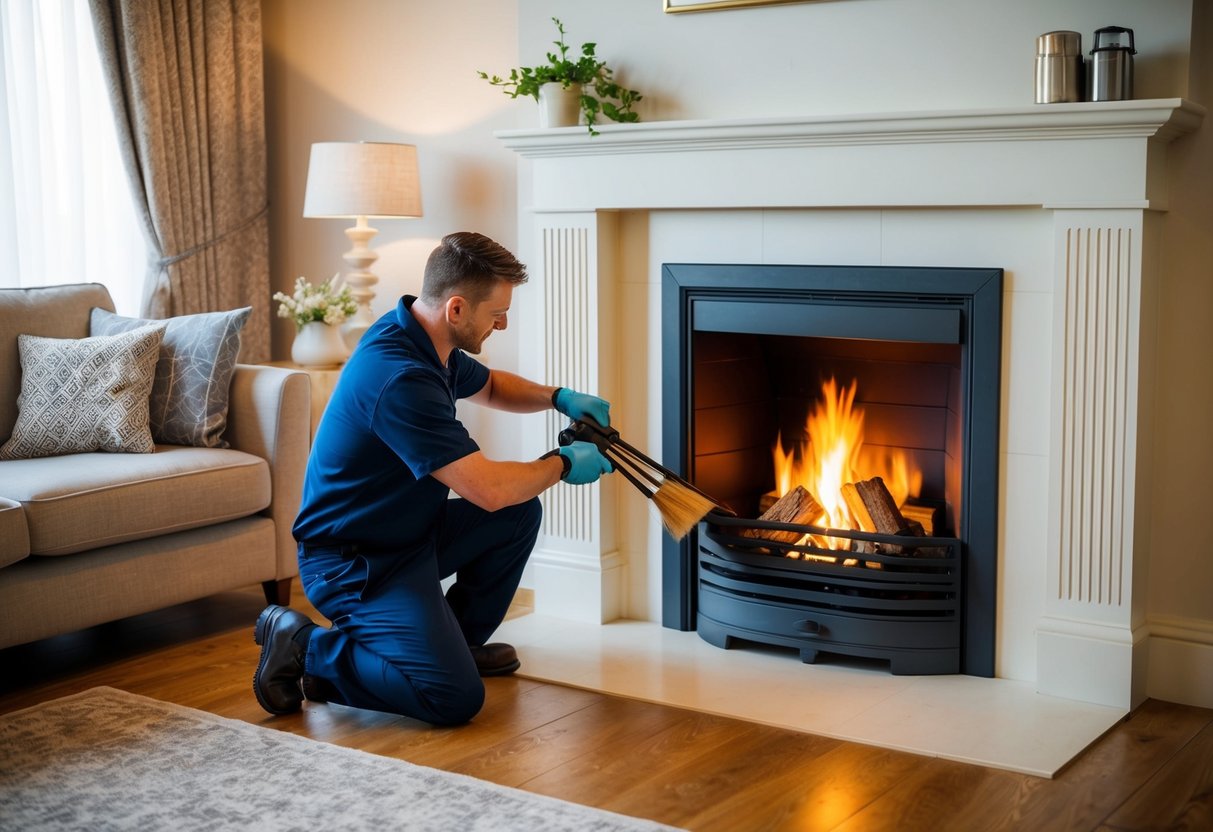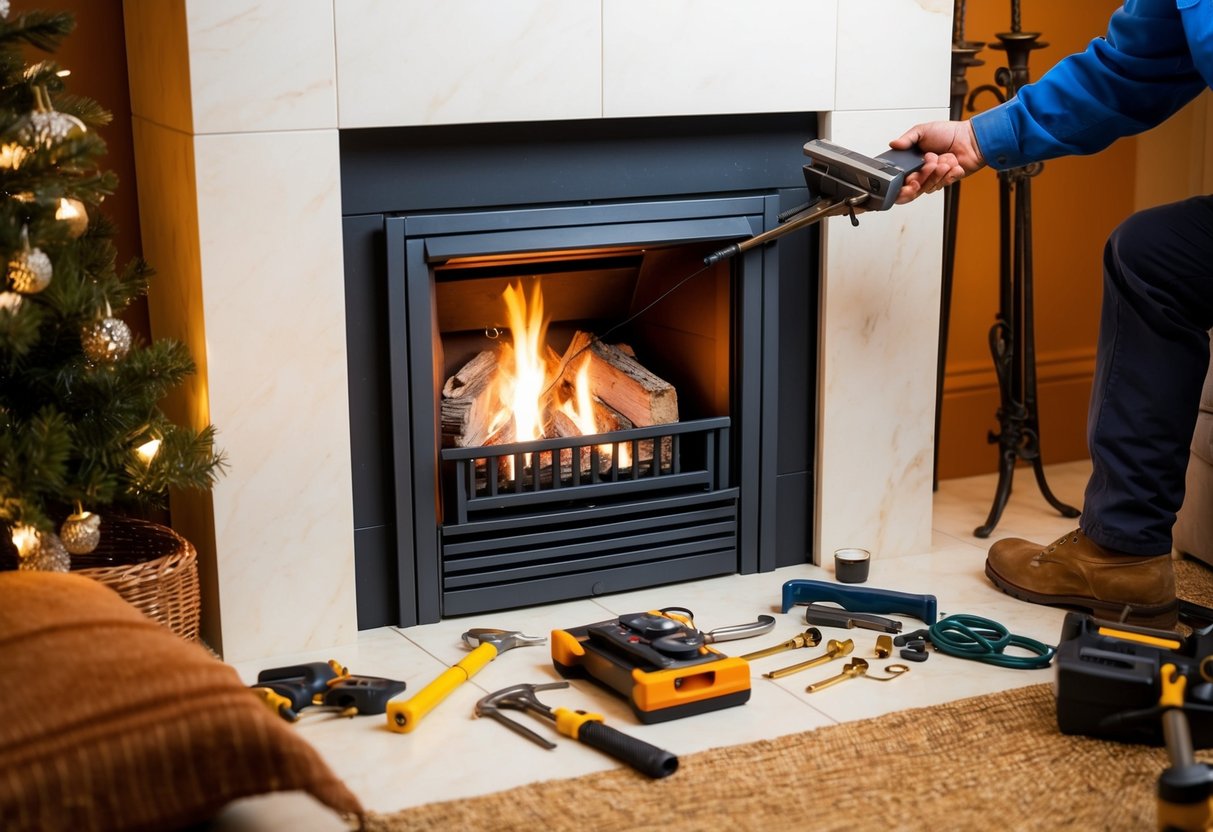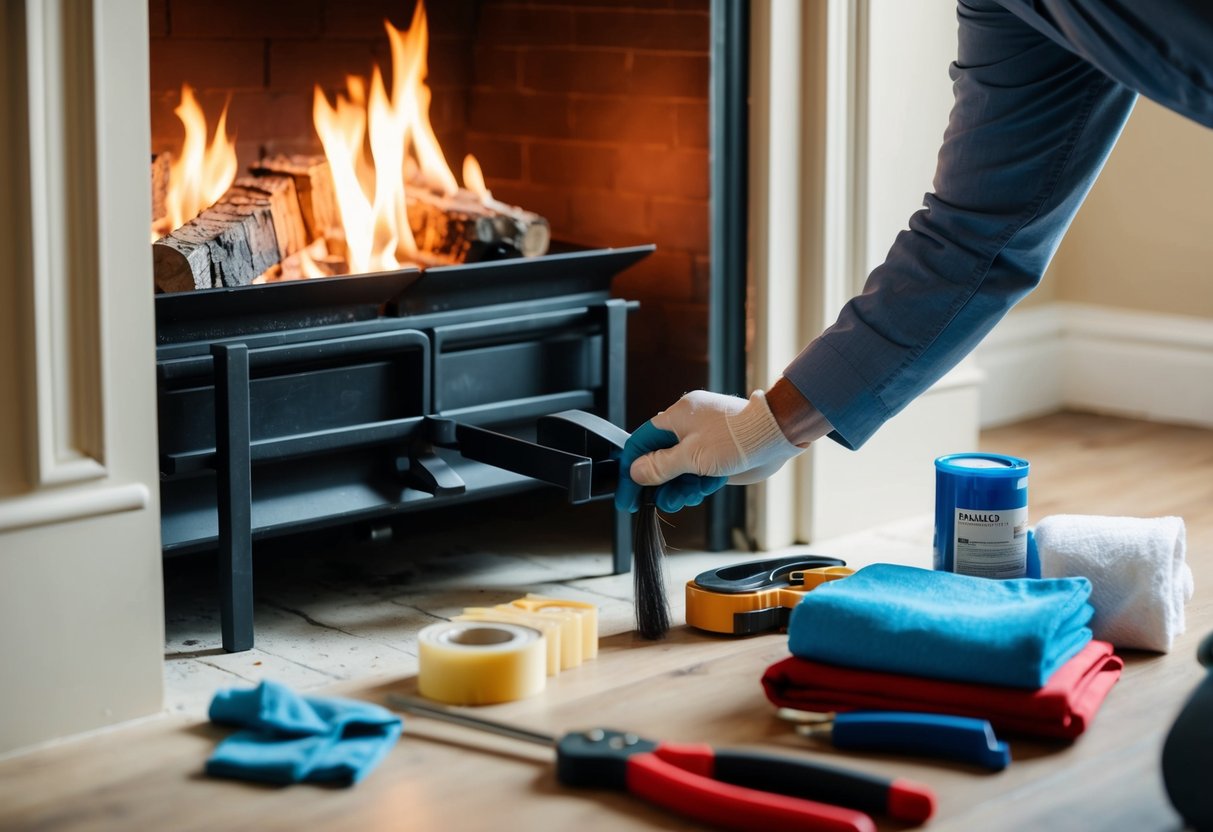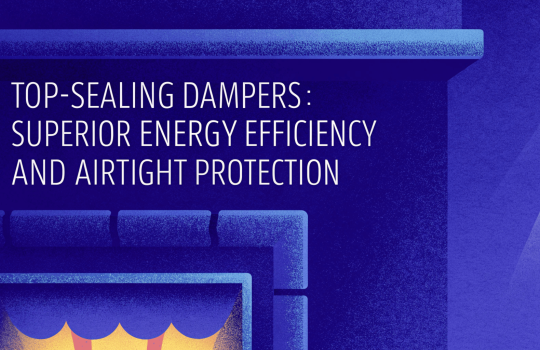The Complete Guide to Fireplace Damper Maintenance: Essential Steps for Winter Warmth
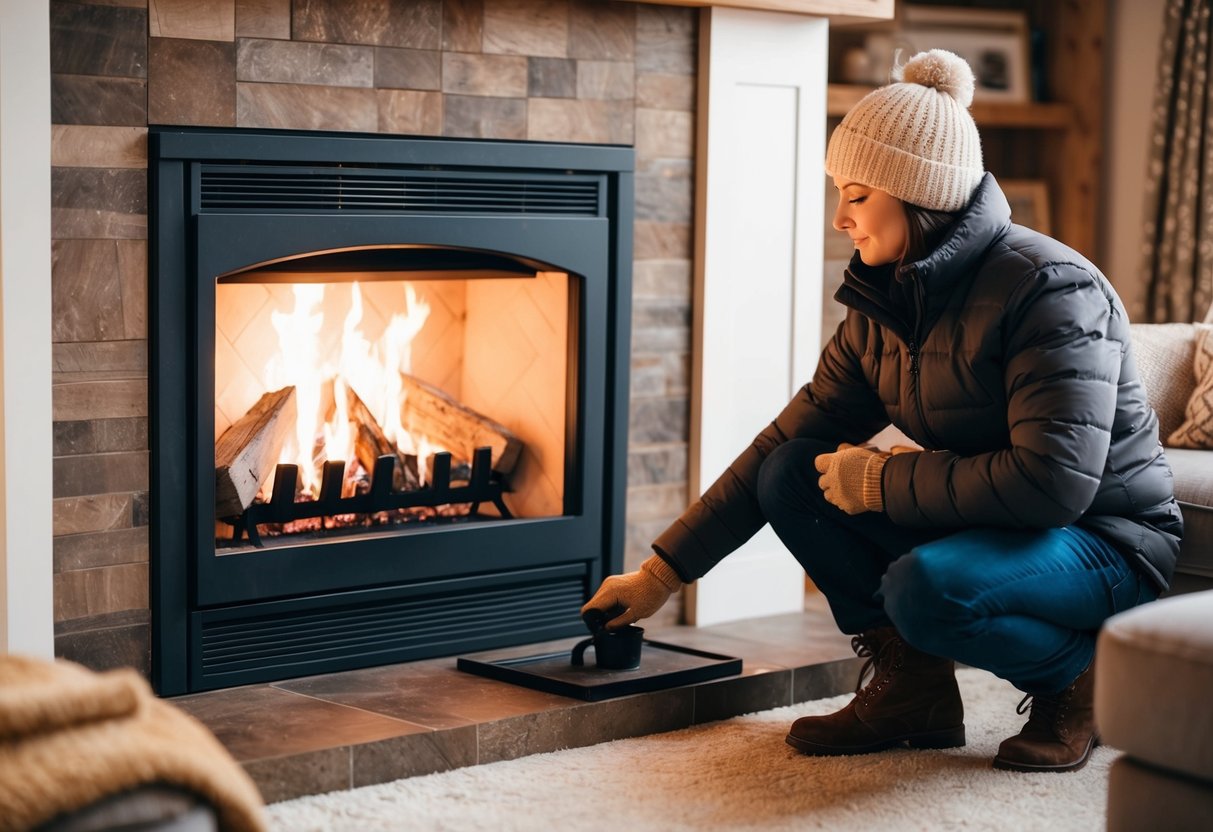
As winter approaches, many homeowners look forward to cozy evenings by the fireplace. A well-maintained fireplace damper is crucial for a safe and efficient fire. Regular damper maintenance can prevent heat loss, improve energy efficiency, and ensure proper ventilation.
We’ll guide you through the essential steps of fireplace damper upkeep. From understanding how dampers work to recognizing signs of wear, this comprehensive guide covers everything you need to know. We’ll explore routine maintenance tasks you can perform yourself and when it’s time to call in a professional.
Preparing your fireplace for the cold season doesn’t have to be daunting. With our expert tips and tricks, you’ll be ready to enjoy warm, worry-free fires all winter long. Let’s dive into the world of fireplace damper maintenance and ensure your home stays cozy and safe.
Key Takeaways
- Regular damper maintenance improves fireplace efficiency and safety
- Recognizing signs of damper wear helps prevent costly repairs
- Seasonal preparation ensures optimal fireplace performance throughout winter
Understanding Fireplace Dampers
Fireplace dampers play a crucial role in the efficiency and safety of fireplaces. We’ll explore the different types of dampers and their essential functions.
Types of Fireplace Dampers
Throat dampers are the most common type, located just above the firebox. We often find these in older homes, with a metal plate controlled by a handle or chain.
Top-mounted dampers sit at the top of the chimney. These provide a tighter seal when closed, helping to prevent heat loss and keep out debris and animals.
Bottom-mounted dampers are installed at the base of the flue. They offer excellent sealing capabilities and are easy to operate from inside the home.
Function and Importance
Dampers control airflow in the chimney, regulating the fire’s intensity and preventing heat loss when the fireplace isn’t in use. We open the damper before lighting a fire to allow smoke to escape.
When closed, dampers prevent warm air from escaping through the chimney, improving energy efficiency. They also keep out cold drafts, rain, and pests.
Proper damper operation is essential for safety. An open damper ensures toxic gases like carbon monoxide exit the home. Regular maintenance helps dampers function correctly, protecting your home and family.
Signs of Damper Wear and Malfunction
Regular inspection of your fireplace damper is crucial for maintaining its functionality and efficiency. Recognizing early signs of wear can prevent more serious issues down the line.
Visual Inspection Tips
We recommend examining your damper at least twice a year. Look for visible rust or corrosion on the damper plate and frame. Check for any warping or misalignment that could prevent a proper seal.
Run your hand along the edges to feel for any gaps or unevenness. Shine a flashlight around the damper when closed to spot any light coming through, indicating potential leaks.
Inspect the damper handle or chain for smooth operation. Any sticking or resistance could signal internal problems.
Common Damper Issues
Stuck dampers are a frequent problem, often caused by built-up creosote or debris. We’ve seen cases where animals nest in chimneys, obstructing damper movement.
Warped damper plates can result from extreme heat exposure over time. This distortion prevents a tight seal, leading to drafts and energy loss.
Rusted or corroded components may cause the damper to seize up or fail to close properly. In severe cases, parts can break off entirely.
Loose or damaged seals around the damper edges reduce its effectiveness. This can allow cold air to enter or warm air to escape, impacting your home’s energy efficiency.
Routine Damper Maintenance
Regular maintenance of your fireplace damper is crucial for optimal performance and safety. We’ll cover essential cleaning techniques and proper lubrication methods to keep your damper in top condition.
Cleaning Techniques
To clean your fireplace damper, start by removing any debris or soot buildup. Use a wire brush to scrub the damper plate and frame gently. For stubborn residue, apply a non-toxic cleaner designed for fireplaces.
Vacuum loose particles with a shop vac or brush them into the firebox for easy removal. Pay special attention to the edges and hinges where debris often accumulates.
For metal dampers, check for signs of rust. If present, sand the affected areas lightly and apply a high-temperature rust-inhibiting paint.
Lubrication and Adjustment
Proper lubrication ensures smooth operation of your damper. Apply a heat-resistant, dry lubricant to the pivot points and moving parts. Avoid using oil-based products, as they can attract dust and become sticky when heated.
Test the damper’s movement after lubrication. It should open and close easily without sticking or squeaking. If issues persist, check for misalignment or warping.
Adjust the damper if necessary. Tighten loose screws or bolts, and realign the plate if it’s not seating properly. For cable-operated dampers, inspect the cable for fraying or stretching and replace if needed.
Regular maintenance will extend your damper’s lifespan and improve your fireplace’s efficiency.
Professional Inspection and Repair
Regular professional inspections and timely repairs are crucial for maintaining a safe and efficient fireplace damper. Experts can identify issues that may not be apparent to homeowners and provide specialized solutions.
Seasonal Preparation and Care
Proper fireplace damper maintenance requires attention throughout the year. We’ll cover essential tasks to perform before winter and after the burning season ends.
Pre-Winter Checklist
Before the cold sets in, we recommend a thorough inspection of your fireplace damper. Check for any signs of rust, debris, or damage. Clean the damper plate and surrounding areas with a wire brush to remove soot buildup.
Lubricate moving parts with a high-temperature lubricant to ensure smooth operation. Test the damper’s opening and closing mechanism several times to confirm it’s working correctly.
Verify the damper seal is intact and creating a proper closure. Replace worn or damaged seals to prevent heat loss and drafts.
End-of-Season Practices
As winter concludes, it’s crucial to prepare your fireplace damper for the off-season. Start by thoroughly cleaning the damper and chimney to remove accumulated creosote and soot.
Leave the damper slightly open during summer months to allow air circulation and prevent moisture buildup. This practice helps deter rust and mold growth.
Schedule a professional chimney inspection to address any issues that may have developed over the winter. They can perform necessary repairs or replacements before the next burning season.
Consider installing a chimney cap if you don’t already have one. It keeps out pests and prevents water damage during the warmer months.
Frequently Asked Questions
Proper fireplace damper maintenance is crucial for a safe and efficient heating system. These common questions address key aspects of damper care and upkeep.
What are the key signs that indicate my fireplace damper needs maintenance?
Look for difficulty opening or closing the damper. Rust, creaking noises, or visible debris are also warning signs. If smoke doesn’t draw up the chimney properly, your damper may need attention.
How often should I perform maintenance on my fireplace damper?
We recommend inspecting and maintaining your fireplace damper at least once a year. It’s best to do this before the start of the heating season. More frequent checks may be necessary if you use your fireplace often.
Can I conduct fireplace damper maintenance myself, or should I hire a professional?
Basic maintenance can be done by homeowners. This includes cleaning and lubricating the damper. For complex issues or if you’re unsure, it’s wise to consult a professional chimney sweep.
What are the steps involved in a typical fireplace damper maintenance routine?
Start by inspecting the damper for damage. Clean off soot and debris with a wire brush. Apply a high-temperature lubricant to moving parts. Check the seal and adjust if necessary.
How can I identify and resolve common problems with a sticky or jammed fireplace damper?
A sticky damper often results from rust or buildup. Clean the damper thoroughly and apply lubricant. If it’s jammed, check for obstructions like fallen bricks or animal nests. Persistent issues may require professional help.
What materials and tools are required for DIY fireplace damper maintenance?
You’ll need a flashlight, wire brush, high-temperature lubricant, and protective gloves. A vacuum with a hose attachment is useful for removing debris. A fireplace poker can help with checking damper movement.



